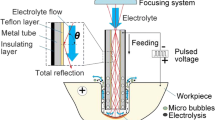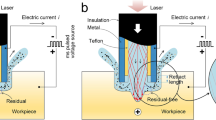Abstract
Laser and electrochemical machining (LECM) is extensively researched due to its high efficiency and good surface quality. Laser and shaped tube electrochemical machining (Laser-STEM) is a novel hybrid process, in which both the laser beam and electrolyte jet are guided to the machining zone through the inner hole of a specially designed tubular electrode. This process could be utilized to process small holes with a larger depth and a higher controlled precision, compared with the existing LECM processes. In Laser-STEM, the direct laser processing and the enhanced electrochemical machining (ECM) rate allow the high-efficiency material removal. ECM that is synchronously occurred in the side gap guarantees the high surface quality of the processed small holes. Through the total internal reflection of the laser beam in the inner hole of the tubular electrode, the laser energy is transmitted to the machining zone in high efficiency, and the laser energy has been confined in the inner hole exit area. Theoretical and experimental results showed that the electric current density in the machining zone for ECM could be increased by the assistance of a laser, which enhances the material removal rate of ECM. With the self-developed experimental setup, microcavities with a depth of 2 mm and small holes with a depth of 5 mm have been fabricated. A comparison of the effects of various machining parameters shows that the machining precision and material removal rate were improved by 60.7% and 122.7%, respectively. Both the machining precision and the material removal rate could be increased by using higher laser power. The mechanisms of machining precision improvement by adopting laser to STEM were explored, considering the generation of the passivating layer in the machining zone. Laser-STEM was also adopted to fabricating three-dimensional structures such as groove and channel.














Similar content being viewed by others
Data availability
The authors confirm that the data supporting the findings of this study are available within the article.
References
Uhlmann E, Mullany B, Biermann D, Rajurkar KP, Hausotte T, Brinksmeier E (2016) Process chains for high-precision components with micro-scale features. CIRP Ann Manuf Technol 65:549–572
Zhang Y, Xu Z, Zhu D, Xing J (2015) Tube electrode high-speed electrochemical discharge drilling using low-conductivity salt solution. Int J Mach Tool Manu 95:10–18
Lee HT, Tai TY (2003) Relationship between EDM parameters and surface crack formation. J Mater Process Technol 142:676–683
Tangwarodomnukun V, Likhitangsuwat P, Tevinpibanphan O, Dumkum C (2015) Laser ablation of titanium alloy under a thin and flowing water layer. Int J Mach Tool Manu 89:14–28
Chavoshi SZ, Luo X (2015) Hybrid micro-machining processes: areview. Precis Eng 41:1–23
Lauwers B, Klocke F, Klink A, Tekkaya AE, Neugebauer R, Mcintosh D (2014) Hybrid processes in manufacturing. CIRP Ann Manuf Technol 63:561–583
Saxena KK, Qian J, Reynaerts D (2018) A review on process capabilities of electrochemical micromachining and its hybrid variants. Int J Mach Tool Manu 127:28–56
Shin YS, Jeong SH (2003) Laser-assisted etching of titanium foil in phosphoric acid for direct fabrication of microstructures. J Laser Appl 15:240–245
Li L, Achara C (2004) Chemical assisted laser machining for the minimization of recast and heat affected zone. CIRP Ann Manuf Technol 53:175–178
Eckert S, Vollertsen F (2018) Mechanisms and processing limits of surface finish using laser-thermochemical polishing. CIRP Ann Manuf Technol 67:201–204
Zhang Z, Feng Q, Cai M, Huang L, Jiang Y (2015) Research on stress-etching complex microstructure of aluminum alloy in laser electrochemical machining. Int J Adv Manuf Technol 81:2157–2165
Long Y, Liu Q, Zhong Z, Xiong L, Shi T (2015) Experimental study on the processes of laser-enhanced electrochemical micromachining stainless steel. Optik 126:1826–1829
Mehrafsun S, Messaoudi H (2018) Dynamic process behavior in laser chemical micro-machining of metals. J Manuf Mater Process 2:54
Stephen A, Sepold G, Metev S, Vollertsen F (2004) Laser-induced liquid-phase jet-chemical etching of metals. J Mater Process Technol 149:536–540
Metev S, Stephen A, Schwarz J, Wochnowski C (2003) Laser-induced chemical micro-treatment and synthesis of materials. RIKEN Rev 50:47–52
Pajak PT, Desilva AKM, Harrison DK, Mcgeough JA (2006) Precision and efficiency of laser assisted jet electrochemical machining. Precis Eng 30:288–298
Silva AKMD, Pajak PT, McGeough JA, Harrison DK (2011) Thermal effects in laser assisted jet electrochemical machining. CIRP Ann Manuf Technol 60:243–246
Zhang H, Xu J, Wang J (2009) Investigation of a novel hybrid process of laser drilling assisted with jet electrochemical machining. Opt Lasers Eng 47:1242–1249
Stephen A, Vollertsen F (2010) Mechanisms and processing limits in laser thermochemical machining. CIRP Ann Manuf Technol 59:251–254
Malik A, Manna A (2018) Multi-response optimization of laser-assisted jet electrochemical machining parameters based on gray relational analysis. J Braz Soc Mech Sci 40:148
Saxena KK, Qian J, Reynaerts D (2020) A tool-based hybrid laser-electrochemical micromachining process: experimental investigations and synergistic effects. Int J Mach Tool Manu 155:1.3569
Shin HS, Chung DK, Park MS, Chu CN (2011) Analysis of machining characteristics in electrochemical etching using laser masking. Appl Surf Sci 258:1689–1698
Kikuchi T, Wachi Y, Takashi T, Sakairi M, Suzuki RO (2013) Fabrication of a meniscus microlens array made of anodic alumina by laser irradiation and electrochemical techniques. Electrochim Acta 94:269–276
Sun A, Chang Y, Liu H (2018) Metal micro-hole formation without recast layer by laser machining and electrochemical machining. Optik 171:694–705
Duan W, Mei X, Fan Z, Li J, Wang K, Zhang Y (2020) Electrochemical corrosion assisted laser drilling of micro-hole without recast layer. Optik 202:163577
Wang Y, Yang F, Zhang W (2019) Development of laser and electrochemical machining based on internal total reflection. J Electrochem Soc 166:E481–E488
Wang Y, Yang F, Zhang G, Zhang W (2019) Fabrication of deep and small holes by synchronized laser and shaped tube electrochemical machining (Laser-STEM) hybrid process. Int J Adv Manuf Technol 105:2721–2731
Fang X, Wang X, Wang W, Qu N, Li H (2017) Electrochemical drilling of multiple small holes with optimized electrolyte dividing manifolds. J Mater Process Technol 247:40–47
Tabie VM, Koranteng MO, Yunus A, Kuuyine F (2019) Water-jet guided laser cutting technology- an overview. Lasers Manuf Mater Process 6:189–203
Long Y, Xiong L, Shi T, Tang Z (2007) Study of excimer laser electrochemical etching silicon. Proceedings of the 2nd IEEE International Conference on Nano/Micro Engineered and Molecular Systems 117-121
Hutton RS, Port SN, Schiffrin DJ, Williams DE (1996) Photoelectrochemical imaging of the etching and passivation of silicon in aqueous KOH. J Electroanal Chem 418:153–158
Zhang H, Xu J (2010) Modeling and experimental investigation of laser drilling with jet electrochemical machining. Chin J Aeronaut 23:454–460
De Silva AKM, Pajak PT, Harrison DK, McGeough JA (2004) Modelling and experimental investigation of laser assisted jet electrochemical machining. CIRP Ann Manuf Technol 53:179–182
Schuster R, Kirchner V, Allongue P, Ertl G (2000) Electrochemical micromachining. Science 289:98–101
Datta M, Romankiw LT, Vigliotti DR, Gutfeld RJV (1989) Jet and laser-jet electrochemical micromachining of nickel and steel. J Electrochem Soc 136:2251–2256
Wang X, Qu N, Fang X (2019) Reducing stray corrosion in jet electrochemical milling by adjusting the jet shape. J Mater Process Technol 264:240–248
Funding
This research was supported by the National Natural Science Foundation of China (Grant No. 51905525, U1609208), the Natural Science Foundation of Zhejiang (Grant No. LQ19E050003), the Key Deployment Projects of the Chinese Academy of Sciences (Grant No. ZDRW-CN-2019-01), the Key Research and Development Program of Zhejiang (Grant No. 2020C01036), and the Natural Science Foundation of Ningbo (Grant No. 2019A610152).
Author information
Authors and Affiliations
Contributions
Y.F. Wang and W.W. Zhang developed the idea for the study, Y.F. Wang designed the study, performed the research, analyzed data, and wrote the paper.
Corresponding author
Ethics declarations
Conflict of interest
The authors declare that they have no conflict of interest.
Consent to participate
Not applicable.
Consent to publish
Not applicable.
Additional information
Publisher’s note
Springer Nature remains neutral with regard to jurisdictional claims in published maps and institutional affiliations.
Rights and permissions
About this article
Cite this article
Wang, Y., Zhang, W. Theoretical and experimental study on hybrid laser and shaped tube electrochemical machining (Laser-STEM) process. Int J Adv Manuf Technol 112, 1601–1615 (2021). https://doi.org/10.1007/s00170-020-06558-2
Received:
Accepted:
Published:
Issue Date:
DOI: https://doi.org/10.1007/s00170-020-06558-2




